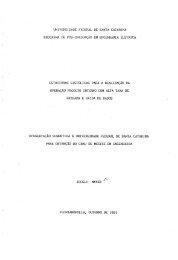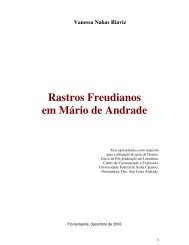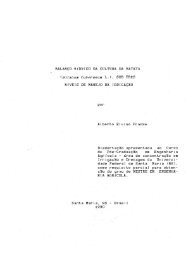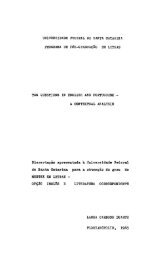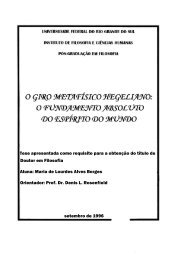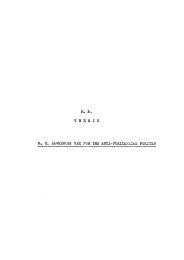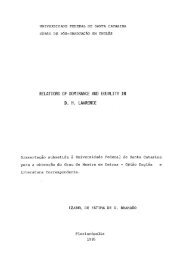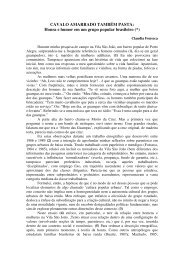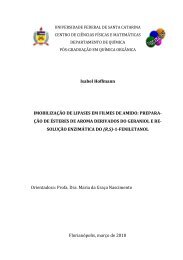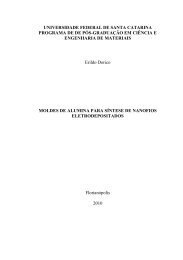Tropical ginsberg
Tropical ginsberg
Tropical ginsberg
Create successful ePaper yourself
Turn your PDF publications into a flip-book with our unique Google optimized e-Paper software.
59<br />
Devoração das imagens conflitantes que encenam<br />
uma cultura brasileira. Esta devoração se atribui<br />
aos participantes: apropriando-se dos elementos<br />
disparatados, justapostos, que formam uma<br />
‘síntese imagética’[...] produzindo a evidenciação<br />
do processo de constituição das contradições<br />
anunciadas. 123<br />
The work consisted of a path that the spectator was invited to<br />
stroll across, and the “landscape” beside the path was composed of<br />
bananas, araras, sand, exotic plants, and small tents, or “penetráveis,” in<br />
which the spectator was invited to enter, the path ended in a tent which<br />
had a television set, turned on at all times. The proposition was to show<br />
the diverse agents of everyday urban life, all, in one small path;<br />
everything, from the slums, to extreme stereotypical portraits of Brazil –<br />
such as the bananas, and exotic landscapes – was contained in the path,<br />
and as the spectator strolled through it he/she would interpret it through<br />
his/her own perspective.<br />
Perhaps like few artists of the early s 1960s, Hélio Oiticica<br />
managed to combine various artistic elements into his art, producing a<br />
“supra-sensorial” 124 art, an art which would involve elements of<br />
perception such as audition, vision, and tact, as well as the participation<br />
of the observer. “Parangolé” was Oiticica’s first major 125 experiment<br />
towards this “supra-sensorial” art, it consisted of several pieces of cloth,<br />
sometimes even other materials such as plastic, or latex, sewed together<br />
into one gigantic entanglement, very much like a flag, or a kaleidoscopic<br />
patchwork quilt. The observer-spectator became a participantprotagonist,<br />
and was invited to hear music while trying to put on the<br />
“Parangolé.” 126<br />
123123<br />
Favaretto, Celso. “Tropicália: A Explosão do óbvio,” Tropicália: Uma Revolução na<br />
Cultura Brasileira [1967-1972]. Basualdo, Carlos (org): São Paulo, Cosac Naify, 2007. 94.<br />
124<br />
Oiticica, Hélio, “Aparecimento do Supra-sensorial,” Aspiro ao Grande Labirinto. Rio de<br />
Janeiro: Rocco, 1986. 103.<br />
125<br />
I consider the “Parangolé” more significant, or “major,” than the previous experimentation<br />
of Oiticica, his “Bólides” (1962) - which consited of glass-objects the public could manipulate<br />
filled with all sorts of materials, condensing a colorful image - because the “Parangolé” is a full<br />
object, and needs the spectator’s full integration with it to exist. Unlike the “Bólide,” which can<br />
be viewed-admired even when on a table, the “Parangolé” does not “exist,” cannot be viewedadmired<br />
if it is exposed lifeless, hung up, or on a table.<br />
126<br />
Illustrious fellow citizens like Torquato Neto, and complete strangers, from our dancing<br />
Mangueira to the grim subways of New York, dressed the Parangolé.



